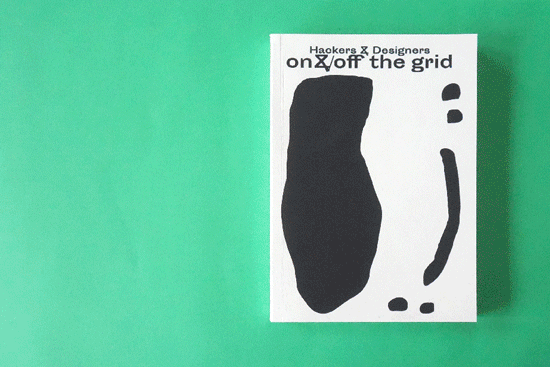On & Off the Grid Publication
In 2017, Hackers & Designers investigated forms of dependence and obedience to technologies embedded in our daily working and living environments. In developing an elaborate hands-on program throughout the year, which peaks around July and August during the H&D Summer Academy (HDSA2017), we posed questions such as: How can we, as modern nomadic workers who often do not differentiate between work and private life, look critically at infrastructure, networks, and systems that we rely on? Are we, as steadily connected (net)workers, capable of disconnecting from existing grids? Can we rethink and build self-sustaining environments that shape our future practices in unexpected ways?
Hackers & Designers reflects on their activities in 2017 in this publication. In particular, we consider the learnings and questions raised during the investigation of processes of going on and off the grid. Taking this publication as an opportunity to reach out to the amazing beings who have collaborated with H&D in 2017, we aim to push forward self-initiation and hands-on and self-directed approaches to research – and to open up insights and discussions with other individuals and collectives.
As Hackers & Designers bridges disciplines and cultures, we are always looking for metaphors and concepts that address technology critically yet leave space for engagement on different levels. We approach the notion of the grid quite openly – for instance, as a metaphor for social connectivity as well as in the context of straightforward energy grids and information networks. Some of our participants are not experienced with the hands-on hacking approach. We notice that relatable topics and humorous means help lower the barrier to understanding technology as potentially transformable. By adding an accessible yet critical component, makers and thinkers get a chance to meet, work together, and confront each other. The common theme of investigating means of going on and off the grid functioned as a form of glue in that context, holding together approaches and ways of thinking that would usually conflict or disregard each other. The starting point for developing a program around the notion of *getting prepped* came about during quite a cliche outdoor experience in California. Cutting costs via camping but not being particularly outdoor-types, we were confronted by our lack of survival skills. This experience spurred some of the following reasons to go off the grid (in no particular order):
- To practice independence
- To self control
- To detect alternatives
- To research alternatives
- To use alternatives
- To train consciousness
- To change the pace
- To count our blessings
- To save money
- To spend money
- To break free from money
- To be agile
- To meet like-minded people
- To eat differently
- To spark curiosity
- To be assertive
- To be responsive
- To change perspective
- To be free
- To be flexible
As a result of the efforts to consciously and critically connect and disconnect, H&D has started questioning some of its own habits as an organization including micro-economies and dependencies. H&D is yet another organization engaging in now-arcane processes, such as writing long funding applications. More developed means of communication have resulted in the perception of H&D as a professionalized or institutionalized collective. H&D is often approached as if it has structural means and steady staff. Furthermore, H&D is expected to grow as an organization. But, what do we want H&D to actually grow into? Is H&D trying to be an educational institution, an agency, a think-tank? And what are the consequences?
This collection of texts addresses the often conflicting routes that influence the questions, actions, and future structure of Hackers & Designers.
- Media Choreographies: Interview with Joana Chicau
- DIY Activism: Interview with Ivanka Annot
- Levels of Autonomy
- The Making of Hackers & Designers Website
- Feminist Search Engine
- Ending Hunger with Farming Bots
- and more to come online soon!
On & Off the Grid
Published by Hackers & Designers
Edition curated by Anja Groten and Juliette Lizotte
2018, Amsterdam
All sources referenced in this publication were accessed during 2017.
Design Anja Groten and Juliette Lizotte using the PJ Machine by Sarah Garcin.
The PJ Machine, Sarah Garcin Nowadays, the free software movement and the diversity of open source tools encourage designers, artists, and developers to question the nature of the tool they are using and its place in their creative process. They are invited to learn, modify, and create their own tools. Creating tools forms an integral part in the work of a graphic designer. The tool shapes the work. Can we imagine new kinds of publishing tools that change the way we present our works, create printed matter, and more? Sarah Garcin tries to answer this question by creating the PJ Machine (Publishing Jockey Machine), a box with arcade buttons to control web interface for live publishing. The Machine allows the creation of a layout design with text and images and the generation a pdf to print. The participants of HDSA2017 were invited to imagine and prototype new and open source publishing tools. The tools created during the Summer Academy offer new kinds of interactions and revolutionize the publication process.
Images All images were taken during the Summer Academy 2017 by Jorge Bakker or provided by the author of the text unless otherwise specified.
Typefaces Libre and open source typefaces from Velvetyne Type Foundry Bilbo by Hélène Marian Srodogora Trickster and Bluu Next by Jean-Baptiste Morizot Hyper Scrypt and Solide Mirage by Jérémy Landes Sporting Grotesque by Lucas Le Bihan Résistance by A collective Gulax by Morgan Gilbert Fengardo Neue by Loïc Sander Blocus by Martin Desinde
Printing Stencilzolder, Amsterdam - Cover silkscreen by Wyber Zeefdruk, Amsterdam
Binding Hennink, Amsterdam
Editor Genevieve Costello
Copy-Editor Genevieve Costello
Coordination Juliette Lizotte
